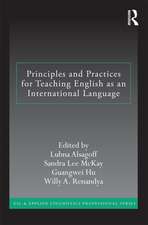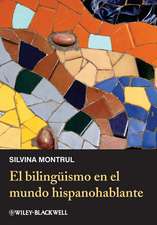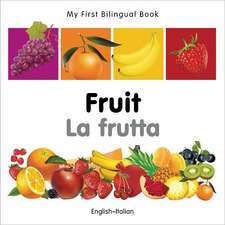Handbook of Heritage, Community, and Native American Languages in the United States: Research, Policy, and Educational Practice
Editat de Terrence G. Wiley, Joy Kreeft Peyton, Donna Christian, Sarah Catherine K. Moore, Na Liuen Limba Engleză Hardback – 13 ian 2014
Timely and comprehensive, this state-of-the-art overview of major issues related to heritage, community, and Native American languages in the United States, based on the work of noted authorities, draws from a variety of perspectives—the speakers; use of the languages in the home, community, and wider society; patterns of acquisition, retention, loss, and revitalization of the languages; and specific education efforts devoted to developing stronger connections with and proficiency in them. Contributions on language use, programs and instruction, and policy focus on issues that are applicable to many heritage language contexts. Offering a foundational perspective for serious students of heritage, community, and Native American languages as they are learned in the classroom, transmitted across generations in families, and used in communities, the volume provides background on the history and current status of many languages in the linguistic mosaic of U.S. society and stresses the importance of drawing on these languages as societal, community, and individual resources, while also noting their strategic importance within the context of globalization.
| Toate formatele și edițiile | Preț | Express |
|---|---|---|
| Paperback (1) | 956.07 lei 6-8 săpt. | |
| Taylor & Francis – 6 ian 2014 | 956.07 lei 6-8 săpt. | |
| Hardback (1) | 1468.25 lei 6-8 săpt. | |
| Taylor & Francis – 13 ian 2014 | 1468.25 lei 6-8 săpt. |
Preț: 1468.25 lei
Preț vechi: 2049.57 lei
-28% Nou
Puncte Express: 2202
Preț estimativ în valută:
280.95€ • 293.93$ • 233.39£
280.95€ • 293.93$ • 233.39£
Carte tipărită la comandă
Livrare economică 03-17 aprilie
Preluare comenzi: 021 569.72.76
Specificații
ISBN-13: 9780415520669
ISBN-10: 0415520665
Pagini: 424
Dimensiuni: 178 x 254 x 33 mm
Greutate: 0.91 kg
Ediția:New.
Editura: Taylor & Francis
Colecția Routledge
Locul publicării:Oxford, United Kingdom
ISBN-10: 0415520665
Pagini: 424
Dimensiuni: 178 x 254 x 33 mm
Greutate: 0.91 kg
Ediția:New.
Editura: Taylor & Francis
Colecția Routledge
Locul publicării:Oxford, United Kingdom
Cuprins
CONTENTS
Preface
Acknowledgments
Section I: Foundations of Heritage, Community, and Native American Language Education
Introduction
Terrence G. Wiley, Joy Kreeft Peyton, Donna Christian, Sarah Catherine K. Moore, and Na Liu
1. Demographic Realities, Challenges, and Opportunities
Molly Fee, Nancy C. Rhodes, and Terrence G. Wiley
2. The Problem of Defining Heritage and Community Languages and Their Speakers: On the Utility and Limitations of Definitional Constructs
Terrence G. Wiley
3. Heritage Language Students: Profiles and Possibilities
Guadalupe Valdés
4. Three Hundred-Plus Years of Heritage Language Education in the United States
Joshua A. Fishman
5. Policy Considerations for Promoting Heritage, Community, and Native American Languages
Terrence G. Wiley
6. Documenting Language Loss and Endangerment: Research Tools and Approaches
Joseph Lo Bianco
7. Professional Opportunities for Heritage Language Speakers
María Carreira
8. Research on Heritage Language Issues
Nelleke Van Deusen-Scholl
Section II: Commonly Taught Languages
Introduction
Ofelia García
9. Spanish in the United States
Kim Potowski
10. French Heritage Language Communities in the United States
Jane F. Ross and Fabrice Jaumont
11. German as a Heritage Language in the United States
Renate Ludanyi
12. Italian and Italians in the United States
Anna De Fina
13. Portuguese Heritage Bilingualism in the United States
Jason Rothman and Tiffany Judy
Section III: Critical and Less Commonly Taught Languages
Introduction
Scott McGinnis
14. Arabic in the United States
Jeff Bale
15. Being “Critical:” Implications for Chinese Heritage Language Schools
Shuhan C. Wang
16. The Journey of Hindi in the United States
Surendra and Vijay Gambhir
17.Russian Heritage Language Learners: From Students’ Profiles to Project-Based Curriculum
Olga Kagan
Section IV: Native American Languages
Introduction
Teresa L. McCarty
18. Navajo
Larisa Warhol and Jeston Morris
19. Pueblo Languages of the Southwest
Christine Sims
20. Oowaaha Myaamiaataweenki: Miami is Spoken Here
Daryl Baldwin
21. Hawaiian: A Native American Language Official for a State
William H. Wilson
22. Warm Springs Languages
Valerie Switzler and Erin Flynn Haynes
Section V: Languages with Strong Community Connections
Introduction
Sarah J. Shin
23. Japanese in the United States
Kimi Kondo-Brown
24. Community Support for Korean as a Heritage Language in the United States
Jin Sook Lee
25. Yiddish: A Jewish Language in the Diaspora
Netta Avineri
26. American Sign Language as a Heritage Language
Sarah E. Compton
27. Khmer
Wayne E. Wright
28. Filipino in the United States: Heritage Language Perspectives
Joseph Axel
Section VI: Promotion of Heritage, Community, and Native American Languages
Introduction
Wayne E. Wright
29. Digital Stories in Heritage Language Education: Empowering Heritage Language Learners Through a Pedagogy of Multiliteracies
Polina Vinogradova
30. Heritage Language Development and Identity Construction Throughout the Life Cycle
Agnes Weiyun He
31. Stakeholder Views of Community-based Heritage Language Programs: Chinese and Korean Cases
Na Liu and Byeong-Keun You
32. Program Models for Heritage Language Education
Sarah Catherine K. Moore
33. Assessment of Heritage Language Learners: Issues and Directions
Margaret E. Malone, Joy Kreeft Peyton, and Katie Kim
34. Preparing Teachers to Work With Heritage Language Learners
Ana María Schwartz Caballero
35. Funding for Heritage Language Programs
Sarah Catherine K. Moore
Afterword
Heritage, Community, and Native American Language Education: Looking to the Future
Joy Kreeft Peyton and Donna Christian
Contributors
Index
Preface
Acknowledgments
Section I: Foundations of Heritage, Community, and Native American Language Education
Introduction
Terrence G. Wiley, Joy Kreeft Peyton, Donna Christian, Sarah Catherine K. Moore, and Na Liu
1. Demographic Realities, Challenges, and Opportunities
Molly Fee, Nancy C. Rhodes, and Terrence G. Wiley
2. The Problem of Defining Heritage and Community Languages and Their Speakers: On the Utility and Limitations of Definitional Constructs
Terrence G. Wiley
3. Heritage Language Students: Profiles and Possibilities
Guadalupe Valdés
4. Three Hundred-Plus Years of Heritage Language Education in the United States
Joshua A. Fishman
5. Policy Considerations for Promoting Heritage, Community, and Native American Languages
Terrence G. Wiley
6. Documenting Language Loss and Endangerment: Research Tools and Approaches
Joseph Lo Bianco
7. Professional Opportunities for Heritage Language Speakers
María Carreira
8. Research on Heritage Language Issues
Nelleke Van Deusen-Scholl
Section II: Commonly Taught Languages
Introduction
Ofelia García
9. Spanish in the United States
Kim Potowski
10. French Heritage Language Communities in the United States
Jane F. Ross and Fabrice Jaumont
11. German as a Heritage Language in the United States
Renate Ludanyi
12. Italian and Italians in the United States
Anna De Fina
13. Portuguese Heritage Bilingualism in the United States
Jason Rothman and Tiffany Judy
Section III: Critical and Less Commonly Taught Languages
Introduction
Scott McGinnis
14. Arabic in the United States
Jeff Bale
15. Being “Critical:” Implications for Chinese Heritage Language Schools
Shuhan C. Wang
16. The Journey of Hindi in the United States
Surendra and Vijay Gambhir
17.Russian Heritage Language Learners: From Students’ Profiles to Project-Based Curriculum
Olga Kagan
Section IV: Native American Languages
Introduction
Teresa L. McCarty
18. Navajo
Larisa Warhol and Jeston Morris
19. Pueblo Languages of the Southwest
Christine Sims
20. Oowaaha Myaamiaataweenki: Miami is Spoken Here
Daryl Baldwin
21. Hawaiian: A Native American Language Official for a State
William H. Wilson
22. Warm Springs Languages
Valerie Switzler and Erin Flynn Haynes
Section V: Languages with Strong Community Connections
Introduction
Sarah J. Shin
23. Japanese in the United States
Kimi Kondo-Brown
24. Community Support for Korean as a Heritage Language in the United States
Jin Sook Lee
25. Yiddish: A Jewish Language in the Diaspora
Netta Avineri
26. American Sign Language as a Heritage Language
Sarah E. Compton
27. Khmer
Wayne E. Wright
28. Filipino in the United States: Heritage Language Perspectives
Joseph Axel
Section VI: Promotion of Heritage, Community, and Native American Languages
Introduction
Wayne E. Wright
29. Digital Stories in Heritage Language Education: Empowering Heritage Language Learners Through a Pedagogy of Multiliteracies
Polina Vinogradova
30. Heritage Language Development and Identity Construction Throughout the Life Cycle
Agnes Weiyun He
31. Stakeholder Views of Community-based Heritage Language Programs: Chinese and Korean Cases
Na Liu and Byeong-Keun You
32. Program Models for Heritage Language Education
Sarah Catherine K. Moore
33. Assessment of Heritage Language Learners: Issues and Directions
Margaret E. Malone, Joy Kreeft Peyton, and Katie Kim
34. Preparing Teachers to Work With Heritage Language Learners
Ana María Schwartz Caballero
35. Funding for Heritage Language Programs
Sarah Catherine K. Moore
Afterword
Heritage, Community, and Native American Language Education: Looking to the Future
Joy Kreeft Peyton and Donna Christian
Contributors
Index
Notă biografică
Terrence G. Wiley is President, Center for Applied Linguistics, USA and Professor Emeritus, Arizona State University, USA.
Joy Kreeft Peyton is Senior Fellow, Center for Applied Linguistics, USA.
Donna Christian is Senior Fellow, Center for Applied Linguistics, USA.
Sarah Catherine K. Moore is Senior Research Associate, Center for Applied Linguistics, USA.
Na Liu is Senior Research Associate, Center for Applied Linguistics, USA.
Joy Kreeft Peyton is Senior Fellow, Center for Applied Linguistics, USA.
Donna Christian is Senior Fellow, Center for Applied Linguistics, USA.
Sarah Catherine K. Moore is Senior Research Associate, Center for Applied Linguistics, USA.
Na Liu is Senior Research Associate, Center for Applied Linguistics, USA.
Recenzii
"This anthology has a very broad scope. The chapters are relatively short, but the book is nonetheless comprehensive and well organized. Contributors include established, well-respected experts such as Joshua Fishman, as well as expert but newer scholars. ... A needed and useful collection. Summing Up: Highly recommended. All academic levels/libraries." - C.L. Thompson, Indiana University-Purdue University, Fort Wayne, in CHOICE, October 2014
"This welcome, and timely work [is distinguished by] its breadth and depth of coverage and expertise of the contributors." - G. Richard Tucker, Department of Modern Languages, Carnegie Mellon University, USA
"A valuable contribution to helping policy-makers and educators better understand the dimensions of the challenges and the largely untapped resources that reside in our heritage communities." - Catherine Ingold, Director, National Foreign Language Center, University of Maryland, USA
"…makes available in a single volume the current knowledge, insights, and experiences of many important leaders and researchers in the Heritage Language field. Usable by both professionals and students, it can serve as an introduction to the field, as a reference for those already involved in it, and as an inspiration to those who wish to contribute to this increasingly important enterprise." - Linda Godson, Coordinator, Heritage Language Initiative, Portland State University, USA
"The Handbook of Heritage, Community, and Native American Languages in the United States makes an important contribution to the field ... The Handbook is meaningful for a large audience: virtually every chapter offers something for not just heritage school stakeholders, but also public school teachers, researchers, and other interested parties. ... Although the field is still emerging and its borders remain fuzzy, the Handbook covers the subject effectively, and brings out the richness and variety inherent in the field." - Heritage Language Journal
"This welcome, and timely work [is distinguished by] its breadth and depth of coverage and expertise of the contributors." - G. Richard Tucker, Department of Modern Languages, Carnegie Mellon University, USA
"A valuable contribution to helping policy-makers and educators better understand the dimensions of the challenges and the largely untapped resources that reside in our heritage communities." - Catherine Ingold, Director, National Foreign Language Center, University of Maryland, USA
"…makes available in a single volume the current knowledge, insights, and experiences of many important leaders and researchers in the Heritage Language field. Usable by both professionals and students, it can serve as an introduction to the field, as a reference for those already involved in it, and as an inspiration to those who wish to contribute to this increasingly important enterprise." - Linda Godson, Coordinator, Heritage Language Initiative, Portland State University, USA
"The Handbook of Heritage, Community, and Native American Languages in the United States makes an important contribution to the field ... The Handbook is meaningful for a large audience: virtually every chapter offers something for not just heritage school stakeholders, but also public school teachers, researchers, and other interested parties. ... Although the field is still emerging and its borders remain fuzzy, the Handbook covers the subject effectively, and brings out the richness and variety inherent in the field." - Heritage Language Journal
Descriere
This volume provides an overview of major issues related to acquisition, use, retention, loss, and revitalization of heritage languages spoken in the United States as they are learned in the classroom, transmitted in families, and used in communities.
















